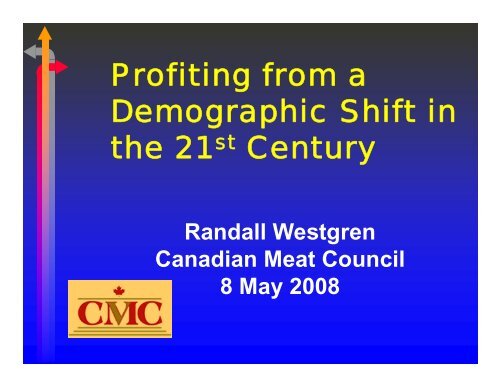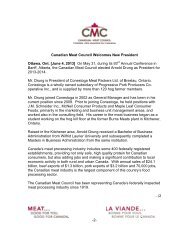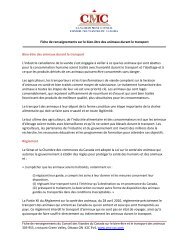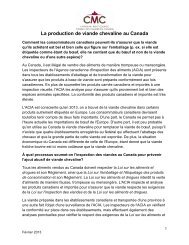Profiting from a Demographic Shift in the 21st Century
Profiting from a Demographic Shift in the 21st Century
Profiting from a Demographic Shift in the 21st Century
Create successful ePaper yourself
Turn your PDF publications into a flip-book with our unique Google optimized e-Paper software.
<strong>Profit<strong>in</strong>g</strong> <strong>from</strong> a<strong>Demographic</strong> <strong>Shift</strong> <strong>in</strong><strong>the</strong> 21 st <strong>Century</strong>Randall WestgrenCanadian Meat Council8 May 2008
What drives consumer choice?– <strong>Demographic</strong>s– Lifestyle– Habit vs. Novelty-seek<strong>in</strong>g– Learn<strong>in</strong>g (<strong>in</strong>formation)
Population age dynamics -Canada% population over 5050%40%30%28.9%32.0%35.4%38.3% 3%20%10%0%2001 2006 2011 2016
Ethnic Diversity - Canada%immigrants <strong>in</strong> 1990-1996 period50%49%40%30%27%20%10%0%7%7%Europe Africa Asia Hispanic
Ethnic Diversity -US% <strong>in</strong>crease <strong>in</strong> population p 1998- 200840%30%36%31%20%10%6%13%8%0%W hite Black Asian Hispanic Total
Dual Income Families - Canada% Dual-<strong>in</strong>come Family Households70%60%50%40%30%20%10%0%37%61%1980 1995 200570%
Dual Income Families - US% Dual-<strong>in</strong>come Family Households60%50%40%30%20%10%37%45% 50%0%1978 1998 2008
Small households - Canada% of s<strong>in</strong>gle households40.0% 0%30.4% 33.6%36.1%36.4%30.0%20.0%10.0%0.0%1971 1981 1991 1996
Small households - US% of s<strong>in</strong>gle households40%30%24%30%33%20%10%0%1978 1998 2008
What does it mean when we have– <strong>in</strong>creased s<strong>in</strong>gle-person households?– <strong>in</strong>creased dual-<strong>in</strong>come households?– <strong>in</strong>creased population over 50?– <strong>in</strong>creased numbers of Asian and Hispanicconsumers?
First-order effects• Dual <strong>in</strong>comes imply• higher disposable <strong>in</strong>come• <strong>in</strong>creased time constra<strong>in</strong>ts for“consumption”• Therefore <strong>in</strong>creased demand for high-endproducts AND• convenient meal solutions• “beh<strong>in</strong>d-<strong>the</strong>-wheel-friendly” foods
First-order effectsS<strong>in</strong>gle person households imply• smaller packages• convenience• high away-<strong>from</strong>-home consumption• lower “food <strong>in</strong>terest”
First-order effectsGrowth <strong>in</strong> ethnic consum<strong>in</strong>g populationsimplies• different product mix at retail• diversity <strong>in</strong> food service
First-order effectsAg<strong>in</strong>g population implies higherdisposable <strong>in</strong>comes
Second-order order effects– Affluence tends to break traditional sociodemographicconsumption patterns– The products that are brought out forethnic markets are adopted by broaderconsumer markets– Comb<strong>in</strong>ation of time constra<strong>in</strong>ts andaffluence leads to “eaterta<strong>in</strong>ment”
The problems with demographics• They imply behavioral norms based on “whatyou look like”• <strong>Demographic</strong>s are no longer stable predictorsover time• “What we look like” is less important than“how we behave”• Let’s call this “lifestyle” for now
After all <strong>the</strong>se years• “Dis-moi ce que tu manges, je te dirai ce quetu es.” - Jean An<strong>the</strong>lme Brillat-Savar<strong>in</strong>1825
Lifestyle - behavior% who eat a home-cooked d<strong>in</strong>ner 6-7 nights per week“loners” married married notmarriedw/o kids w/ kids w/ kids44% 46% 45% 45%Source: Peter Hart for Grocery Mfrs Assn, 1998
Lifestyle - behavior% who d<strong>in</strong>e with entire household 6-7 nights per week“loners” married id married id not marriedw/o kids w/ kids w/ kidsN/A 60% 52% 54%Source: Peter Hart for Grocery Mfrs Assn, 1998
Lifestyle - behavior% who buy a ready-to-eat meal 2 or more nights perweek“loners” married married not marriedw/o kids w/ kids w/ kids39% 27% 33% 42%Source: Peter Hart for Grocery Mfrs Assn, 1998
Lifestyle - behavior% who use microwave almost all <strong>the</strong> time/veryoften“loners” married married not marriedw/o kids w/ kids w/ kids43% 36% 33% 29%
Some emerg<strong>in</strong>g lifestyle l issues• Fastest grow<strong>in</strong>g product categories <strong>in</strong> <strong>the</strong>“center of <strong>the</strong> store”• TASTE, INDULGENCE, VARIETY• FUNCTIONALITY
Some emerg<strong>in</strong>g lifestyle issues• “Echo Boomers” are a strange, volatileage cohort• BIG <strong>in</strong>to self-<strong>in</strong>dulgence• Most likely to shop <strong>in</strong> Supercenters• Low <strong>in</strong>comes with high consumptionaspirations• Novelty-seekers• Ethnicity doesn’t drive purchases
More learn<strong>in</strong>g opportunities• Experimentation, novelty-seek<strong>in</strong>g, and ethnic“boundary-jump<strong>in</strong>g” occur <strong>in</strong> <strong>the</strong> foodservicesector• Good news – s<strong>in</strong>ce we have 1 ½ generationsof <strong>in</strong>ept home cooks• Ironically, TV may save us, especially withEcho Boomers
Habituation vs. Novelty– Habituation is a classic response to <strong>the</strong> hugenumber of consumption choices before us– Food products are EXPERIENCE GOODS,as are food retailer patronage, and restaurantchoice
Habituation vs. NoveltyPositivesatisfactionNoveltyNegativesatisfactionThe Wundt curve
Habituation vs. Novelty– There is a constant tension between <strong>the</strong> comfort ofhabitual purchases and <strong>the</strong> search for novelty– Market<strong>in</strong>g expenditures flow to this tension:• re<strong>in</strong>force positive satisfaction for exist<strong>in</strong>g products• present new choices <strong>in</strong> product categories– Marketers battle over which brands/items will enterour “evoked set” dur<strong>in</strong>g <strong>the</strong> shopp<strong>in</strong>g task
How do we “make a market”?• Consumers on one side with• Chang<strong>in</strong>g basic demographics• Increas<strong>in</strong>gly specific behavior segments• Increas<strong>in</strong>gly unstable “presence” <strong>in</strong> segments• Interest t<strong>in</strong> novelty• Food marketers with• Huge capacity to generate new products• Blurred, fragmented market channels
How do we “make a market”?• Use <strong>the</strong> metaphor of maps:• Consumers have an <strong>in</strong>complete mental map of <strong>the</strong>array of choices <strong>the</strong>y have to purchase food(products, sources)• Marketers have a fuzzy, <strong>in</strong>complete mental mapof consumer needs, wants, desires• Both parties are “navigat<strong>in</strong>g” g with imperfectmaps, try<strong>in</strong>g to meet at <strong>the</strong> cash register
The complication of “what isbe<strong>in</strong>g purchased?”• Consumers don’t really consume products• They consume complex goods that <strong>the</strong>y “construct”<strong>from</strong> products bought at retail OR <strong>the</strong>y buy complexgoods that someone constructs for <strong>the</strong>m (foodservice)• The value <strong>the</strong>y get <strong>from</strong> <strong>the</strong>se complex goods comes<strong>from</strong> <strong>the</strong> comb<strong>in</strong>ation of characteristics <strong>the</strong>yconsume
Characteristics of Consumption Goods• Intr<strong>in</strong>sic characteristics <strong>in</strong> food products• Nutritive• Organoleptic• Physical/ l/biologicali l• Extr<strong>in</strong>sic characteristics• Psychic: tradition, sophistication, economy• Enterta<strong>in</strong>ment• ConvenienceWhere do “story” products fit?
Navigat<strong>in</strong>g– Consumers navigate <strong>from</strong> memory, even if<strong>the</strong>ir mental map of consumption possibilitiesdoesn’t match up with “reality” -- habituation– To f<strong>in</strong>d novelty <strong>in</strong> <strong>the</strong> landscape ofconsumption possibilities, <strong>the</strong>y need signposts‣Who makes <strong>the</strong> signposts?
‣Signposts:Navigat<strong>in</strong>g• Consumer advertis<strong>in</strong>gi• Po<strong>in</strong>t-of-purchase <strong>in</strong> retail• Food service <strong>in</strong>dustry• The “early warn<strong>in</strong>g system” for novelty <strong>in</strong> <strong>the</strong> US.• Note that <strong>the</strong> food retail system is generallydevoid of personal <strong>in</strong>formation sources,unlike most consumer products markets,except…
















